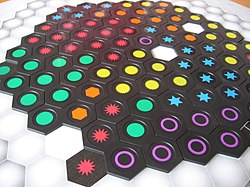Game
Each match consists of one game. The scoring charts are placed beside the board, both on the same side, with the same orientation and visible to both players. The first-named player plays first.
Each tile can be placed so that it touches any tile that is down or one of the special colour start cells. A player may change his rack if he has none of the colours in which he has the fewest points in, otherwise, a player's rack is replenished at the end of his turn.
A tile may be played for 0 points.
If a player gets a colour to 18 he gets another go but without replenishing his rack. It is possible to have more than one consecutive go. If a player gets 2 colours to 18 with the same move, he only gets one additional go.
The game continues until there is no room left on the board or a player gets 18 in all of the six colours. The score is worked out on the colour with the fewest points and the winner is the player with the highest among the lowest value; in case of a tie you go ahead with the second colour with the second-fewest points, and so on.
The winner gets 1 VP, while his opponent gets 0 VPs. In case of a draw (only if all the 6 colours are in the same position), both get ½ VP. At the end of each game, the levels of the colours with the fewest points and their differences are reported.
Time
Each player has 10 minutes. During his time the player declares aloud his score and moves the cubes (the opponent has to check in this very moment). If the player wants to change his rack, he has to declare it and to show his tiles before pressing the button.
As a player presses the button, he only can replenish his rack. If a player runs out of time, he stops playing and his opponent carries on playing till the game ends or his time expires. The winner is then decided in the usual way.

